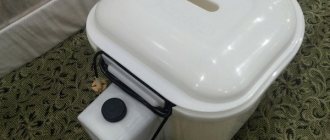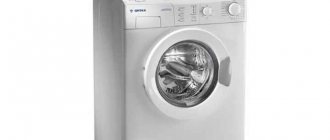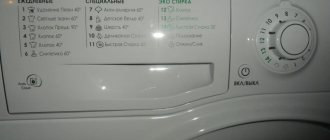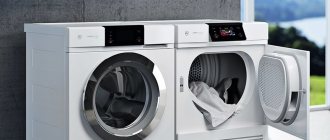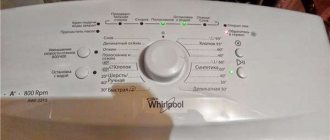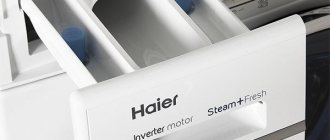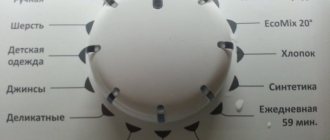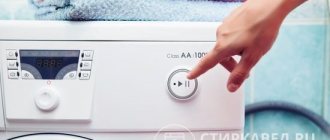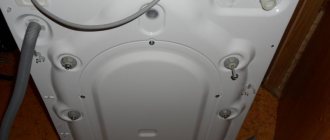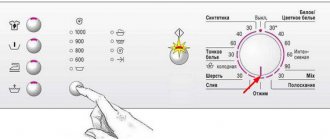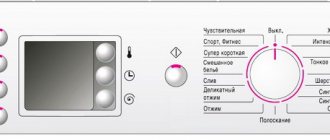Malyutka’s job is to mechanize hand wash
. Of course, you can soak the laundry in the machine, wash and rinse it by manually changing the water. Some models are equipped with a reverse system that allows you to spin the drum in the other direction. Manufacturers also report the presence of spin in some models.
The operating principle of the machine is simple. Based on the manufacturer's recommendations, a certain amount of dirty laundry is placed in the tank. The owner of such equipment independently fills the drum with water at the required temperature. Using a mechanical regulator, a mode is selected (some units have a delicate wash) and the process starts. At the end of the work, things need to be taken out and the water drained manually.
. If desired, you can fill the clothes with clean water and rinse them there.
Some Babies, for example, the Fairy 2P model, are equipped with a heated washing mode, which is very convenient if there is no hot water in the house.
Advantages
Undoubtedly, the main advantage of the technology is its dimensions.
: The machine will easily fit into the trunk of a car. And its light weight of 7.5-15 kg allows you to move the Baby, without making titanic efforts, from place to place or even transport it to the dacha. The compactness of the equipment makes it possible to store it on the balcony, under the sink in the bathroom, in the pantry, and, if necessary, take it out and use it at any time.
Economical
– a definite plus, since the mini-washing machine, which in everyday life is called Malyutka, due to its small size and short cycle (6-20 minutes), consumes little electricity. Some models are equipped with a spin function, which takes no more than 5 minutes.
Simplicity of design
– another positive quality of the unit. Since the Malyutka consists of only a tank, an engine and a module, there is practically nothing in the device to break. And this is a weighty argument, considering the cost of repairing household appliances. Summarizing all of the above, we can highlight the advantages of the washing machine, called Malyutka, probably because it previously served as an excellent means for washing children's clothes:
- Small sizes.
- Light weight.
- Economical work.
- Short cycle.
- Practical design.
Such an activator type machine will be a good purchase for using it in the countryside
, where there is neither running water (water is poured through the hatch in the tank manually) nor sewerage. Families living in rented apartments will find this equipment attractive due to its small size and light weight, which allows the Baby to be transported without much difficulty.
Consumer Reviews
Bought for a summer house. She justified herself. It washes not only outer clothing for working in the garden, but also everything else that needs to be washed. At the same time, despite the simplicity of the design, it washes well. There is almost no load on the weak dacha electrical network. It requires almost no attention to itself. We are glad.
Mini Vyatka SM 2Maxim
This car (or rather the money to buy it) was given to us as a wedding gift. The car was purchased in August 2002. During operation, no serious problems were identified. The screw securing the drum pulley to its axis was unscrewed twice. As a result, the drum stopped spinning. I fixed the problem myself using a wrench by removing the back wall. The first time, apparently, it didn’t last, because a few months later it came loose again. I tightened it a second time with all my heart, and it won’t come off anymore. The main drawback, in my opinion, is the frankly lousy preparation of the metal surface of the body for painting. The enamel began to peel off after about three years. I had to tint it with pre-treatment with a rust converter. Now it's gone somewhere else. Overall, the unit is simple and reliable. It works and washes very well. I don’t know how long it will work, but we will only replace it if there is a critical breakdown.
Flaws
- A significant disadvantage that will play a role when choosing such a washing machine is the spin function
, which is not present in all models. Due to its presence, the price of the model also increases. - The small size of the machine will not allow you to load a large amount of laundry into it. Most units have a tank with a capacity of only 2-4 kg. This characteristic feature will not allow you to wash a blanket, blanket or a complete set of bed linen in it.
- Many owners note that Malyutka is
quite
noisy
. For some, such a drawback will seem significant and will be a reason to refuse to purchase.
What types of activator-type washing machines are there?
The simplest model of small-sized “washing machines” is capable of performing the main washing cycle and, after changing the water, rinsing. Some manufacturers produce Malyutka washing machines with a spin cycle, while more modern models have heating.
Products with a spin function can be equipped with a removable centrifuge, which is installed in the tank of the machine, or have two separate tanks - one for washing and rinsing, the other for spinning.
The delivery set includes a hose for manual draining of water and a stand.
What is an activator?
Not every family has an automatic washing machine (AWA). Those who are helped by an activator machine or semi-automatic machine know that the activator is a large ribbed disk mounted in the bottom or side panel of the tank. Its task is to rotate, creating the movement of water. To mix the laundry more intensively, it is equipped with ribs - blades. The discs may have different shapes and diameters, but they all perform one task - mix dirty clothes in water.
After purchasing any household appliance, it is recommended that you familiarize yourself with the rules for its use. This is especially true for washing machines. Many buyers are in too much of a hurry, immediately testing the machine after unpacking without familiarizing themselves with the basic rules for using it. In this article you can read the operating instructions for the Katyusha Vyatka 722R washing machine.
Main characteristics of washing machines of the “Malyutka” type
Depending on the volume of the tank, the load of compact washing machines is from 1 kg to 3.5 kg.
All modern models operate in reverse mode. This allows you to avoid twisting of the laundry, due to the fact that the motor changes the direction of rotation of the activator blades.
Most manufacturers produce Malyutka washing machines with energy consumption characteristics of A+ or A++.
Many models are equipped with a filter to collect fluff or lint, which significantly improves the washing result.
Some machines allow you to wash in two modes - normal and delicate.
Engine test
If you find an engine from a Vyatka-automatic machine in the garage that has been collecting dust on the shelves for a long time, and you want to use it on the farm, but you don’t know whether it’s working, diagnose the device. To test an electric motor, you will need the simplest multimeter and a special digital meter for power, voltage, and current. You can purchase devices in specialized stores or on the Internet.
To begin with, it is better to measure the resistance of the motor windings with a multimeter. Switch the tester to the appropriate mode and alternately lean the probes against pairs of contacts. Normally, the indicators on the device screen will be as follows:
- when measuring resistance between terminals 1 and 5 - 23.2-26.8 Ohms;
- between 1 and 2 contacts – 8-9.2 Ohms;
- 4 and 3 – 51.1-58.9 Ohms;
- 4 and 6 – 51.1-58.9 Ohms;
- between 3 and 6 – 71.6-82.4 Ohms.
If the winding resistance meets the standard values, the motor can usually be used for secondary purposes. However, it is better to perform a more complete diagnosis and check how the motor holds and copes with loads, whether it overheats, and what speed it produces. For these purposes, you will need a special power, voltage and current meter.
Ideally, the measurement results at low and high speeds should be the same both when the rotor rotates clockwise and counterclockwise. If everything is normal, then when the engine accelerates to 370 rpm, the measuring device should produce approximately the following indicators:
- voltage 220-230 Volts;
- power – 290-310 Watts (the figure depends on the specific engine model, perhaps your electric motor will be more powerful);
- current strength - 1.4-1.5 Amperes.
As the RPM increases, the results should be similar. If the electric motor is normal, you can connect it according to the diagram described above. It can become the basis for creating many useful household devices: an emery or lathe, grain or apple crushers, lawn mowers, concrete mixers, etc.
Source
Operating principle and device
Classic Malyutka washing machines consist of a tank into which laundry is loaded, an activator, the rotating blades of which ensure the washing process. The engine starts the process, and the duration of the wash can be adjusted using a control module, which is a simple time relay.
The motor is protected from voltage surges in the network by a capacitor.
More modern models have an electric heater for heating water, but the principle of their operation is the same as that of the simplest products.
DOMOSTROYPlumbing and construction
- Category: Construction
- Link to post
- https://firmmy.ru/
For repairs and other technical issues, click here. Repair of household and office equipment.
Connecting the Vyatka motor - automatic. Krasnodar Kuban.
The electric motor from the Vyatka washing machine is designed to operate in a single-phase network. Consists of two working and two reverse coils. Together with capacitors, they create the direction of shaft rotation.
Vyatka had different modifications of engines, but their characteristics were approximately the same. All of them have two reverse rotation speeds. 2200 rpm min. for spin and 450 rpm. min per wash cycle.
According to the number of connection terminals, the motors were 6-pin and 5-pin.
But their connection diagram was the same - five wire. In 6-pin electric motors, contacts 1 and 4 (the first two) are short-circuited, this is the common terminal for connecting to the network.
The second network wire is connected to one of the two capacitors. Moreover, at one end of the capacitor there is direct rotation, and at the second there is reverse rotation of each speed. For a speed of 2200 rpm, a paper capacitor of 16 microfarads is installed, and for 450 rpm - 12 microfarads. It is advisable to select a capacitor voltage of at least 500 volts.
When turned on correctly, the engines start easily in both directions. The only thing you need to do when reversing the direction of rotation is to wait until the shaft rotation has completely stopped. The windings of these motors cannot withstand high currents.
If the motor operates in cold weather, it is better to disconnect the thermal contact. They rupture at sub-zero temperatures just as they do when overheated.
Thank you for your attention. With uv
Beletsky A.I. 02/14/2015 Kuban Krasnodar
With uv. Beletsky A.I. 02/14/2015 Kuban Krasnodar.
If the washing machine breaks down and the engine is still running, then you can find a use for it. It is suitable as an emery or sharpener. Let's figure out how to bring this to life.
It is necessary to find the terminals of the starting and working windings. The starting winding is for starting, for accelerating it. The winding is working - it works under the load and performs a useful function.
We find two pairs of windings using a tester - a multimeter. We measure their resistance.
The pair with less resistance is the working one.
Using the example of a three-phase asynchronous motor from SM Vyatka-Avtomat:
There are 6 terminal contacts.
The figure shows the resistance values:
The capacitor is native to Vyatka, 16 uF, 500 Volts.
And the connection diagram for 220 volts:
We recommend securing the motor so that it does not damage the connected wires when rotating. To change the direction of movement, we change the terminals of the start winding.
In modern units there may be not 6 wire terminals, but more. Approximate diagram:
The third pair is used to measure speed using a tachometer located on the pulley. For convenience, we connect the start winding through a capacitor for a phase shift.
After starting, we check it for heating. Your hand should tolerate the heating temperature. Otherwise, the temperature is high and the winding may fail.
– wear of bearings due to incorrect clearance of the stator and rotor – dirt and dust in the brushes – large capacitor capacity – interturn short circuits
How to use an activator washing machine
Starting a wash in a compact washing machine is easy. The instructions for the Malyutka washing machine are as follows:
- Install the equipment in the bathroom or other convenient place.
- Remove the lid from the tank and fill with warm or hot water, depending on the type of fabric.
- Add washing powder and mix.
- Place dirty laundry in the tank and close it with a lid.
- Use the toggle switch to adjust the wash duration.
- Plug in the Malyutka washing machine.
- After the wash is finished, unplug the appliance and remove the laundry.
- Using the supplied hose, drain the water into a bathtub or bucket.
- In order to rinse washed items, pour clean cold water into the machine, fold the laundry and set the rinsing time.
- Connect the “Malyutka” to the electrical network.
- After the rinse cycle has finished, remove the wash and drain the water.
- In washing machines with a spin cycle, you need to install a special centrifuge in the tank and fold some of the laundry into it. Set the spin time and turn on the device.
- After the spin cycle is completed, unplug the washing machine and remove the laundry.
Electric motor for a grinder or emery
Purchasing a ready-made sharpening machine is not always possible, primarily due to the high price, and in this case an electric motor from a washing machine or other equipment literally becomes indispensable.
A lot of effort requires the correct layout of the future unit, as well as solving such a technical problem as attaching a grindstone to the motor shaft. In many cases, there is no thread on it, and the diameters of the shaft and the hole in the stone do not match. The usual way out is to use a special part, which must be ordered separately from a turner's workshop. This part may be called a flange, adapter, hub, etc.
The flange to be machined must be fitted onto the shaft and secured with a bolt. In addition, you will need a washer and a nut with threads directed in the direction opposite to the rotation of the motor shaft. Due to this, spontaneous tightening of the nut will occur during operation. Otherwise, the nut will quickly unwind and the stone will fly off.
If necessary, you can change the direction of rotation of the rotor. Washing machines are installed, therefore, it is enough to switch the corresponding windings, and the direction of rotation will change. To start the engine you will need a starter coil. If it is missing, then there is nothing to worry about: when you push the stone in the right direction, the device will work on its own.
To make a sharpening machine, it is not at all necessary to use high-power engines. 400 W is quite enough, and even 100-200 W
Pay attention to the number of revolutions per minute, which should not exceed 3000. Otherwise, a motor with too high a rotation speed may lead to destruction of the grindstone
The best option is an electric motor with 1000 rpm.
Operating a homemade sharpening machine requires strict adherence to safety regulations. First of all, it is necessary to provide a protective casing to protect the worker from abrasive dust and small debris. For this purpose, metal 2.0-2.5 mm thick in the form of a strip folded into a half ring is suitable. In addition, it will be necessary to make a tool rest to ensure the support of the workpieces.
Advantages of "Malyutok"
Compact washing machines have a number of advantages.
First of all, it is small in size; it can be easily stored in a closet or placed even in a small bathroom.
The simple design of the Malyutka ensures its high reliability.
Such washing machines are easy to transport; there is no need for a cargo taxi, since the device will fit in the trunk of a car.
Another significant advantage of activator washing machines is that they can work in conditions where there is no sewage system. This makes them an excellent option for the garden. Heated Malyutka washing machines will make country life much easier; all you need to do is simply pour cold water into them.
The advantage of compact “washing machines” is the fast cycle of the process - together with rinsing, it will take no more than 20 minutes.
Washing in Malyutka saves not only time, but also electricity and water.
And the price of such washing machines is low, which makes them accessible to all segments of the population.
How to extend the life of the device
If you follow the instructions and carefully consider the troubleshooting diagrams for minor problems that are given in it, the equipment will last quite a long time. Please note that using detergents that do not have the “machine wash” symbol will shorten the service life. The most common reasons for calling for repairs, as statistics show, are not manufacturing defects, but blockages or improper operation.
Vyatka Katyusha 522R
Washing machines of the Vyatka Katyusha series have proven themselves well among Russian-made equipment. They are easy to install and use. Having average characteristics, these devices satisfy the needs of average buyers.
Disadvantages of activator washing machines
No matter how ideal compact washing machines may seem at first glance, they also have disadvantages.
The main disadvantage is that the simplest models of machines are not suitable for delicate fabrics (silk, wool).
In “Malyutka” you won’t be able to wash large items - bedspreads and blankets, heavy curtains, since they won’t fit into the tank.
The disadvantage is the high level of noise emitted by the machine, and the fact that the washing process must be controlled.
Many models are not equipped with a spinning centrifuge.
But if you choose a model with spinning and heating, then “Malyutka” can fully replace an automatic washing machine.
History of the Vyatka brand
During the Soviet era, only the wives of party officials and diplomats could boast of foreign washing machines. Everything changed in the late 70s, when the first Vyatka-automatic washing machine, a twin sister of the Italian Ariston model, rolled off the assembly line at a plant in the city of Kirov. At that time, all the neighbors in the house came to see such a miracle of technology.
In the 80th year of the last century, working under the license of Merloni Progetti, he released a trial model “Vyatka-automatic 12”. From the name it is clear that the washing machine had 12 automatic operating modes. At the end of February 1981, the first batch of these models was released in the amount of 100 pieces.
The cost of these devices was not small, it was 495 rubles. Therefore, not everyone could afford such luxury. Over time, the price dropped slightly to 400.
In connection with the advent of the “Vyatka-automatic”, Soviet society became acquainted with another innovation. It was advertised on TV. Advertising for this product was one of the first on television.
Not everyone could buy a domestically produced washing machine, although it was freely sold in stores. In addition to the cost, a certificate from the housing office was also required stating that the electrical wiring at the place of future operation can withstand the corresponding load.
Vyatki were assembled under the license of Marloni Progetti, using Italian equipment for many years. In 2005, due to bankruptcy, the company was bought by the Italian brand Candy. In this regard, production was modernized, and the model range was replenished with modern technical devices with an appropriate set of characteristics.
Review of popular models
Compact and produced mainly in Russia has become a household name for the entire class of products, while in stores you can find washing machines “Slavda”, “Fairy” and others.
The classic model “Malyutka 225” allows you to wash only 1 kg of laundry, the presence of a reverse prevents the laundry from twisting, and there is a timer that allows you to adjust the washing duration.
The machine costs about 3,000 rubles and will become an indispensable assistant in the countryside.
The more modern model “Slavda WS-35E” allows you to wash in two modes - normal and delicate. This washing machine can load 3.5 kg of laundry. The design provides a reverse operating mode. Machine energy consumption class A+.
Fairy washing machines are very popular. The “babies” of this manufacturer have been produced since 1982. The range of models is quite large: from small washing machines with a load of 2 kg to semi-automatic machines with two compartments for washing (rinsing) and spinning.
The Fairy SM-251 model with a capacity of 2.5 kg of dry laundry is equipped with a reverse and a timer that allows you to set the washing time. The weight of the washing machine is 6 kg.
The washing machine “Fairy SMPA-2002” is equipped with a non-removable centrifuge; it can wash 2 kg of laundry. Washing will take a maximum of 15 minutes. The product provides protection against electric shock.
The Rolsen WVL-200S spinning machine allows you to wash 2 kg of laundry. Energy consumption class F, reverse mode available.
Common faults
The warranty period stated by the manufacturer in the instructions is 10 years. In this case, the buyer has the right to free service in case of malfunction for the first 12 months from the date of purchase.
The most common reasons why Vyatka Katyusha 522R, 722R, 1022R washing machines require repair are:
- there is a distinct burning smell;
- the device receives an electric shock or begins to spark at the point of connection with the outlet;
- the equipment does not turn on, the indicators do not light up;
- the automatic machine is too loud, an uncharacteristic knock is heard;
- The wash has started, but the appliance does not draw water;
- after the end of the session it is impossible to open the hatch;
- the laundry remains damp, despite the spin mode running;
- there are cases of water leaking onto the floor;
- the hatch cuff was torn;
- The machine draws water, but does not heat it.
Vyatka-Katyusha
In case of such malfunctions, you should seek help from a specialist. If the equipment is less than one year old, the manufacturer must carry out diagnostics and repairs. To do this, you need to contact the store where the purchase was made, providing a warranty card and a receipt. After 12 months, all work will be paid for by the owner of the washing machine.
Caring for compact washing machines
Despite the simplicity of the design, Malyutka washing machines also require maintenance.
It is necessary to keep it open after washing and wipe the inside of the tank dry to avoid unpleasant odors and mold formation.
To clean the outside of the machine, you can wipe it with a cloth soaked in alcohol-free detergent.
Malyutka washing machines are an excellent solution for summer cottages or private houses without a central sewer system, for small apartments and dormitories.
Along with modern automatic washing equipment, there are activator-type devices. These are compact, simple units without technological frills and devices. The most popular representatives are “baby” washing machines and their analogues.
Mini washing machines have both pros and cons compared to their full-featured counterparts. The feasibility of using a portable unit depends on its operating conditions.
In this article, we will look at popular “baby” models, analyze their design features and operating principles. We will also talk about the proper operation of washing machines of this type and safety precautions when using them.
“Malyutka” is a small-sized washing machine of the activator type. This is not only the name of a specific model, but also the designation of all small-sized devices equipped with a minimum set of options, regardless of the manufacturer and production series.
The device of any “baby” is quite simple.
Main structural components of the equipment:
- Plastic laundry bin
. Most modifications are designed for a load of 1-4 kg, the maximum capacity of individual washing machines is 6 kg. - Activator
. A rotating disk with blades located on the bottom or side wall of the machine body. The element is responsible for mixing the laundry; its additional purpose is to ensure the strength of the plastic tank. - Electrical engine
. The motor drives the “baby’s” heart – the activator. - Capacitor
. The module smoothes out fluctuations in the mains voltage and prevents the failure of the electric motor. - Control module
. Each compact washing machine has a built-in time relay and a control knob on the body. The mechanism allows you to set the washing time based on the soiling of the items and the type of fabric.
The basic package includes: a removable cover, a drain hose and a stand.
The performance of the units is based on the principle of operation of air-bubble semi-automatic devices of the activator type. In fact, the machine solves the only task - performing the main washing cycle
The principle of operation of the “baby” is simple. Dirty laundry is placed in the tank, powder is added and water is poured. After the unit is connected to the network, the operating time is set.
The electric motor provokes rotation of the activator blades, and the laundry begins to mix intensively.
Most models are capable of operating in reverse mode - changing the vector of movement of the activator significantly improves the quality of washing. More advanced “babies” are equipped with the option of heating water and a tank with a centrifuge for spinning
At the end of the cycle, dirty water is drained through a hose. If desired, the machine can also be used to rinse things. The cycle is repeated in a similar way to the previous one, but this time a shorter interval is selected and no detergent is used.
We discussed in more detail the operating principle of an activator-type washing machine in another article.
Repair cost
| Name | Price** |
| Basic services | |
| Visit of the master | for free |
| Departure of the master outside the Moscow Ring Road | 40 rub./km. from MKAD |
| Diagnostics | for free* |
| Simple repair (class 1) | from 500 rub. |
| Repair of medium complexity (class 2) | from 900 rub. |
| Overhaul (class 3) - complete disassembly | from 2500 rub. |
| Removing from a hard-to-reach place | from 400 rub. |
| Removing foreign objects (without disassembly) | from 500 rub. |
| Removing foreign objects (with disassembly) | from 1500 rub. |
| Repair | |
| Cleaning the dryer | from 1400 rub. |
| Closing the drum flaps | from 1200 rub. |
| Tank (including installation/dismantling) | from 1800 rub. |
| Electronic module | from 1500 rub. |
| Adjusting the Drive Belt | from 400 rub. |
| Timer | from 1500 rub. |
| Closing the drum flaps (complete disassembly) | from 2500 rub. |
| Removing the transport fasteners | from 200 rub. |
| Cleaning the drain system | from 1400 rub. |
| Unlocking and opening the hatch | from 500 rub. |
| Replacement | |
| Pressostat | from 900 rub. |
| UBL | from 1100 rub. |
| Surge filter, capacitor, buttons/keys, power cord | from 600 rub. |
| Tank (with dryer) | from 3500 rub. |
| Hatch handle, drum pulley | from 900 rub. |
| Bottom or front counterweight | from 1900 rub. |
| Hatch, hatch hinge, hatch key | from 700 rub. |
| Inlet hose | from 500 rub. |
| Drain pump or pipe | from 1300 rub. |
| Drying timer, drying temperature sensor, constant temperature thermostat | from 800 rub. |
| Rear tank cover | from 2200 rub. |
| Tank (without drying) | from 3000 rub. |
| heating element | from 1300 rub. |
| Fill valve | from 900 rub. |
| Control knob | from 500 rub. |
| Engine / motor (removal and installation) | from 1300 rub. |
| Drive belt | from 700 rub. |
| Bearing and seal | from 3500 rub. |
| Drying heating element, drying fan motor | from 1000 rub. |
| Timer, electronic module, display unit, ROM programming | from 1300 rub. |
| Shock absorbers, springs | from 900 rub. |
| Entire drum | from 3000 rub. |
| Support, cross | from 2400 rub. |
| Hatch cuff | from 1300 rub. |
| Upper counterweight | from 900 rub. |
| Electric harness | from 1400 rub. |
| Hatch cuff on machines with drying | from 1500 rub. |
| Drain hose | from 600 rub. |
| Hatch cuff on narrow cars | from 1400 rub. |
| Temperature control sensor | from 900 rub. |
Advantages and disadvantages of the unit
A simple design and a minimal set of functions explain the low cost of portable equipment.
However, in addition to the affordable price, mini-machines have a number of advantages compared to more advanced units.
Strengths of the compact assistant
Arguments in favor of the “baby”:
- Mobility
. On average, the weight of the device is about 8-10 kg, and its dimensions allow it to be transported in the trunk of a passenger car. - Economical
. During the entire washing cycle it consumes little electricity. Some models of the latest generation correspond to the most economical energy consumption classes A, A+, A++. - Fast washing
. Unlike full-featured washing machines, the “baby” one gets the job done in 10-15 minutes. Another 5 minutes are allotted for rinsing in the machine. - Reliability
. There are no complex mechanisms in the design, so there is nothing special to break. Even if a single element fails, repairs will cost several times less than restoring full-cycle washing equipment. - Versatility
. The device is suitable for any type of fabric that is machine washable. The only note: it is advisable to place particularly delicate items in a special bag.
The mini-machine is autonomous - does not depend on centralized water supply and sewerage. This turns out to be a decisive factor when choosing a “baby” for the dacha.
This unit is the best option for seasonal use, as well as for students and people living in rented premises
Compactness is a definite plus in cramped conditions. The baby can be stored in the pantry, under the sink or on the balcony.
If you have a centralized water supply, and there is very little space in the bathroom, then you can install an automatic mini-machine under the sink. We reviewed the TOP best washing machines under the sink in.
Disadvantages of a miniature model
Based on user reviews, we can highlight several obvious disadvantages of mini-washers:
- Low performance
. In one cycle, the machine is capable of washing up to 2-3 kg of laundry. The “baby” cannot cope with large and heavy things, for example, a set of bed linen, curtains, blankets or outerwear. They will have to be washed by hand. - Noisy work
. Some people refuse the activator technique due to the high-pitched hum. Unlike a fully automated washing machine, a mini-unit cannot be used in the evening or at night. - Increased safety requirements
. Water is an excellent conductor of current. Therefore, all manipulations with laundry must be performed after disconnecting the device from the network.
In terms of ease of use and practicality, the “babies” are significantly inferior to their followers – automatic drum machines. Mini-units are not able to adjust the washing mode to a specific type of clothing or type of soiling.
Even models with a spin cycle require additional human intervention - the water must first be drained and then the items must be transferred to a centrifuge
If you need a more functional version of a washing machine, which provides various washing modes (and in some models, steam treatment and drying), we recommend that you familiarize yourself with.
How to disassemble Vyatka Katyusha with your own hands photo report
To do this, you must first loosen the locknuts on the legs, and then unscrew the legs to the desired height. It is necessary to ensure sufficient clearance between the floor and the body, and most importantly, level the machine, otherwise it will produce more noise during operation. Next, you can begin connecting the machine. The instructions indicate that to connect a Vyatka Katyusha washing machine, a separate electrical outlet with grounding is required. It is powered from a 1.5 square meter copper wire. mm or aluminum per 2.5 sq. mm, and this socket must be protected automatically. We will plug the power cord into the outlet last, first we will connect the machine to the water supply and sewerage system. How to do this is described in the article Installing and connecting a washing machine yourself. Repair of SM Katyusha 1022
The washing machine first works, and then the rotation stops (at the beginning of the “rinse” mode - in one place). The control device works, water is poured in and out, but there is no rotation.
And then there is no rotation in any modes. I assume that the brushes are worn out (one of them, the other one, the one that can be seen, looks normal, and the contact is good, and the contact pin sits rigidly.
And the second brush on the side of the tank cannot be reached unless the engine is removed. Its contact pin is very loose) Maybe due to poor contact of the brush (when the speed increases, a rustling sound appears) the engine overheats and the thermal protection simply turns off.
In this regard, the question is: what is the engine model or the dimensions of the brushes themselves on the Katyusha 1022. The electric model is not indicated on the diagram.
This is what I meant when I talked about slippage. But finding a pulley, at least an ordinary one, is now a question for me.
Added 09-09-2008 18:00 Is it impossible to repair the original pulley? I haven't even taken it off yet.
sadko178 monitor.net.ru Messages08 19:16 Install a pulley with ARDO 600, it fits fine. lenya-ali ParticipantMessages: 56 09-09-2008 20:09 I have little doubt that replacing the pulley will change something, most likely EVO bearings ParticipantMessages: 211 09-11-2008 10:54 lenya-ali wrote: I have little doubt that , replacing the pulley will change something, most likely the bearings and what are they bearing there?? maxx4 Warnings: 1 Messages: 11 11-09-2008 16:04 There is always a knocking sound when rotating such pulleys, it’s the bronze cylinders rolling inside. Many times these pulleys were replaced with ordinary ones (the original Vyatkovo pulley, although they had to be bored). We were unable to disassemble such a pulley, because... As soon as the program is selected, the wash will begin immediately.
- As soon as the program selection knob is turned to the “stop” position and the hatch is unlocked, you can remove the laundry.
- After washing, be sure to turn off the power to the machine and turn off the water. Use a dry cloth to wipe the inside of the detergent bin.
You also need to wipe the hatch cuff, the inner walls of the drum and the front panel if droplets of moisture have gotten on it.
Do not close the hatch after washing; in general, the hatch should be kept closed only during washing; in all other cases it should be kept open.
Well, we have retold the basic information contained in the original instructions.
If factory instructions are required, you can find them below the text of the publication.
Source
The best compact washing machines
Most units for express washing are produced by domestic manufacturers. The machines are located in approximately the same price segment; the main differences between the models are the maximum permissible loading weight and the availability of minor options.
Model #1 – Baby Agate with reverse
A portable semi-automatic machine with top loading and an activator located at the bottom of the tank. The model is a prototype of the classic Malyutka washing machine; the main advantage is the reverse rotation of the disk with blades.
The Ukrainian-assembled model weighs 7 kg, is equipped with an operation timer (1-15 minutes) and has a power of 370 W.
Estimated cost – 50 USD. e. Users note the high efficiency of the machine and the good quality of washing.
Model #2 – activator semi-automatic Fairy SM-2
The popular, time-tested model of the Fairy SM-2 mini-unit has simple, intuitive controls and a reliable engine. Reviews from many users indicate the long-lasting, uninterrupted operation of the assistant.
The washing machine weighs only 14 kg, its dimensions are standard for models of this type - 45 * 44 * 47 cm. The unit's tank is designed to wash 2 kg of laundry, which is enough for periodic use in country life.
According to European standards, the washing quality of activator modifications corresponds to class F. If we take the reference work as 100%, then Fairy SM-2 cleans about 85% of contaminants
Tests have shown that the activator device provides a more gentle cleaning mode in comparison with an automatic machine.
To improve the quality of washing, some users practice pre-soaking laundry directly in the “baby” tank.
Disadvantages include vibration of the housing during operation and cracking of the drain hose over time. The average price for a model is 50-55 USD. e.
Model #3 – heated washing machine Fairy-2P
A technically improved version of the previous model – Fairy-2P. A distinctive feature is the presence of a heating element for heating water. The heating element maintains the optimal temperature throughout the entire washing process.
Additional functionality has also been expanded:
- half load mode is provided;
- possibility of setting temperature;
- safety complex: water and foam level control.
The manufacturer has strengthened the structure itself. The body is made of ordinary plastic, and the tank is made of composite polymer.
Washing machine parameters: productivity – 2 kg of clothes per cycle, unit weight – 15 kg, size – 53*53*48 cm, power consumption – 0.3 kWh/kg, programmer – rotary-double-sided
The manufacturer provides a two-year warranty, the approximate market value of Fairy-2P is 70 USD.
Model #4 – budget car Princess SM-1
The Princess SM-1 washing machine is interesting for its functionality along with its miniature dimensions. The unit is capable of operating in four modes - selection is made via a switch. A reversible type activator is built on board.
The body is made of composite plastic, the weight of the mini washing machine is only 5 kg, and the load capacity is 1 kg. Waterproof index IPX4.
Users respond positively to the performance and quality of the wash. Along with all the advantages, Princess SM-1 has a competitive price - about 60 USD. e.
An additional compliment to the model is its attractive design, blue and white color.
Model #5 – Baby ST 22-30-07 with spin
Some models of semi-automatic washing machines are equipped with a centrifuge. At the end of the wash, the laundry is removed from the tank, the water is drained and a special nozzle is installed inside the tank. The washed items are placed back and the spin mode is set.
One of the representatives of this type of compact washing machine with spin is ST 22-30-07. The machine has a high energy consumption class.
Its capacity is up to 3 kg of laundry per wash cycle. At the same time, there is a centrifuge inside the tank, which allows you to perform a spin corresponding to class E.
Unit parameters: power – 170 W, maximum period of one wash – 15 minutes, 1 spin speed, water temperature – up to 55 °C, device weight – 6 kg
The dimensions of the washing machine are 39*37*55 cm, the possibility of reloading laundry is provided, the operating time in spin mode is 3 minutes.
Other representatives of “babies” with a centrifuge that have gained popularity among users:
- VilGrand V105
– 5 kg, spin – 300 rpm; - Mir MWM 228
– 2.5 kg, nozzle rotation speed – up to 300 rpm; - Vimar VWM 61
– 6 kg, centrifuge speed – 300 rpm.
Almost all activator-type machines provide low spin quality, corresponding to class E
. That is, laundry after processing in a centrifuge loses up to 10-30% of moisture.
Engine connection diagram
The motor from the Vyatka-automatic washing machine is designed to operate in a single-phase network. The motor of the machine consists of a pair of reverse and a pair of working coils. Together with the starting capacitor, they set the direction of movement of the rotor.
Vyatkas of different years of production have excellent engine modifications. However, in general, the technical characteristics of the motors are approximately the same. All electric motors had only two rotor speeds - up to 2200 rpm during spinning, and up to 450 rpm during the main wash.
The electric motor from a Vyatka-automatic machine may have 5 or 6 terminals for connection (motors with 8 terminals are extremely rare).
Regardless of how many pins your motor has, 5 or 6, the connection diagram will be identical. It’s just that in motors with six terminals, contacts 1 and 4 need to be “short-circuited” and a common terminal must be created for inclusion in the electrical network.
With the simplest connection of the engine from the Vyatka-automatic machine (directly to the outlet, without a capacitor and toggle switch), you will need:
- mains plug;
- three wires with plugs.
A separate wire with a plug must be connected to one end of the plug, and a bifurcated cable with different plugs must be connected to the other. Next, we find terminals 1 and 4 on the electric motor. The numbering of the connectors can be seen directly on the plastic case that protects the pins.
The first and fourth terminals must be connected to each other on one wire, so the plugs of the “bifurcated” wiring are connected to them alternately. The second, separate cable is connected to terminal No. 2. After this, you can plug in the plug and the rotor will begin to rotate.
To ensure the reversal of the electric motor, that is, changing the direction of rotation of the rotor to the opposite, you will have to constantly manually swap the position of the ends of the winding. For convenience, it is better to immediately include a toggle switch in the circuit - then the movement of the motor can be switched with a click.
In addition, to protect the engine from increased loads, it is advisable to include a capacitor in the circuit. In Vyatka-automatic machines, a starting device with a capacity of 16 microfarads and a voltage of 500 V is installed as standard.
The connection diagram for a motor with reverse, a toggle switch for adjusting the speed of rotation and a starting protective capacitor is shown in the figure.
Thus, contacts 1 and 4 of the electric motor are also “shorted” together with a bifurcated wire and connected to one of the plugs. Further connection occurs according to the diagram. The second and fifth terminals are connected to the terminals of the first toggle switch, which will change the speed of the motor and turn the engine on/off. Here, to the opposite contacts, outputs 3 and 6 are connected in pairs.
Next, a toggle switch for reverse is added to the circuit. It is connected by wires to the middle switch, its diagonal contacts are powered together. The common wire is connected to the starting capacitor, from which the network cable is connected to the plug. What the design will look like is shown in the figure below.
If everything is done correctly, the engine from the Vyatka car will easily start in both directions. It is important to secure the motor well in place before use, otherwise it may damage its own wiring during operation.
You can switch the direction of movement with the toggle switch only after the rotor has completely stopped.
Step-by-step instruction manual
The procedure for using the “babies” of most modifications is identical. Washing will not cause any difficulties if you follow the basic rules for placing and connecting the washing machine. The main thing is to comply with safety standards.
Selection and preparation of a site
First of all, you should decide on the optimal location of the machine.
Equipment manufacturers advise taking into account a number of installation nuances:
- The washing machine should not be in a cold room
. Sudden temperature changes are extremely undesirable for the engine. If the unit was just brought from the street, then the connection must be made after 3-4 hours. - It is necessary to ensure unobstructed access to the water intake point and socket
. The minimum distance to the walls is 5 cm. This gap will help to avoid increased noise from vibration of equipment. - For ease of draining, the machine can be placed on a wooden grate above the bathtub
. It is advisable to place a rubber mat under the bottom. - The base under the device must be level
and strong - distortions are unacceptable.
Particular attention is paid to connecting equipment - it must be grounded.
To avoid accidental splashes of water on the electrical appliance, it is recommended to cover the casing with plastic film or a piece of cloth. In this case, the ventilation holes must be open
Sequence of actions when washing
The following order of work:
- Unfold the drain hose
with the edge up and fix it in this position. - Place laundry in the tank
, observing the maximum permissible load weight. - Add detergent to the container
. It is better to give preference to products with little foam formation - this will increase the washing efficiency. - Fill the tank with water
to the mark marked on the inside of the housing. - Connect the unit to the network
, set the timer and put the “baby” into operation.
After the time has elapsed, the machine will automatically turn off. If necessary, the cycle can be repeated.
Upon completion of work, the washing machine must be unplugged, lower the hose and drain the dirty water. Remove any remaining liquid by tilting the tank towards the hole.
Before rinsing, clean the container and fill it with water - the temperature of the liquid is about 30-40 °C. Load the laundry, set the timer for 2-3 minutes and turn on the machine. After finishing washing and emptying the tank, the container and the lid should be wiped dry with a cloth.
Safety Basics
Compliance with the rules of connection and operation will prevent emergency situations and also extend the life of the machine.
Basic requirements for maintenance and care of a mini washing machine:
- Do not leave the device running without supervision.
- It is strictly prohibited to touch the switched-on plug with wet hands.
- There is a taboo on heating water in the tank with an electric boiler.
- The machine must not be placed on the ground or washed while on a metal floor.
- It is prohibited to carry the unit connected to the network or filled with water, as well as to operate equipment with signs of electrical defects.
During operation, you must not simultaneously touch the body of a running machine and grounded elements: a bathtub, water heating radiators or a pipeline
Mini-Vyatka - a basin with a motor
With the help of this element, the laundry is spun in the machine and washed. Torsion occurs in different directions, so the fabric is not damaged during washing.
As you can see from the photo, the machine consists of a plastic body and a stand. The body has a built-in motor, timer and other necessary parts for washing. The stand has protrusions with which the machine can be placed directly on the sides of the bathtub. I haven’t tried this myself and always washed on the floor because I thought it was a safer option.
At the bottom of Vyatka there is a hose for draining water. There is a second hose that you can attach to the water faucet and fill the machine. It was not useful to me because it did not fit the size of the faucet in the bathroom.
Equipment: hose for filling water, instructions, stick for removing laundry, stand elements
Instructions on how to wash
Before washing, you need to understand that a little washing machine is nothing more than a basin with a motor. She can spin the laundry while washing it, but the rest is up to the person. The washing process is not complicated, but labor-intensive, although it is easier and more efficient than washing the same amount of clothes by hand.
Where to put
During washing, the Mini-Vyatka must stand on its stand. This will protect it from water that inevitably appears on the floor due to splashes. I don’t recommend placing it on the bathtub because it shakes when it works. High risk of falling.
How much water
To start using the machine, you need to pour water into it. The water level should not reach the mark on the body by about 2 cm. If you pour more, it will splash and flood everything around. I poured water with an iron bucket, having previously heated it on gas. If you have hot water in your water supply, you can pour it straight from the tap. The machine will hold 25 liters.
Watermark. It should be slightly lower than her (about 2 cm).
Select the water temperature to suit you. Bedding can be washed in very hot water, delicate items in lukewarm. You cannot wash it in boiling water: the mechanism will heat up from it through the thin plastic walls and deteriorate.
How much powder
For washing, you can use powder, gel or soap. The powder and gel must be dissolved in water before loading things. Their number should not be large. 50 ml of gel was enough for me to wash, which consisted of 3 loads of laundry. You also need literally 2 tbsp of powder. l., otherwise you won’t rinse it later.
The washer's plug is the most common one.
If you decide to use soap, then soak the items in water and then generously lather each item with it.
How much laundry
The instructions say that the size of one load of dry laundry should not exceed 1.5 kg, and the approximate weight of some types of items is also given there.
From the instructions: the approximate weight of some items.
I tried not to stuff the Mini-Vyatka to capacity: this way it doesn’t wash well and overheats faster, spinning heavy laundry:
- My bed linen is 1.5 size. The duvet cover was always washed alone. Bed sheet with pillowcases.
- Terry towels (50×70) fit 3-4 pieces at a time. To them it was possible to add thin kitchen ones, also in quantities of several pieces.
- Jeans were washed only individually.
- T-shirts, sweatshirts, sweatpants, leggings, panties, and socks were grouped together by eye. For example, I could combine pants + socks, pants + leggings, panties + leggings + T-shirts.
- Windbreakers only alone.
- Only one 150x200 bedspread fit.
- Tulle and window curtains were washed separately.
- I have never washed a blanket, pillows, or down jackets in the Mini-Vyatka, because they do not fit there in volume.
How much time
I expect 3 loads of laundry per wash. For example, first comes a pile of towels. I take them out and put on the duvet cover. After this comes the turn of sheets and pillowcases. Each batch is washed 3 times for 6 minutes (the maximum time that can be set on the timer). This works out to a total of 18 minutes per load. I tried washing for less time, but the quality of washing did not satisfy me.
Mechanical timer for 6 minutes.
The manufacturer strongly recommends not to use the machine continuously for more than 1.5 hours. When washing for a long time, you need to take a break for 30 minutes.
My washes have always been protracted. The washing itself lasted 1.5 hours. Then I would give the machine a break, empty it, and refill it again. Only after that did I start rinsing. The rinse lasted about the same as the first stage. In total, each wash took me 3 free time.
Washing
Between settings of the timer, particularly dirty items can be washed with soap. I did this with socks. The machine stops, I catch the necessary things in it, wash it, put it back and start the timer again. In this way, I achieved better quality in washing problematic items.
How to rinse
Washed clothes can be rinsed manually in the bathtub, or directly in Vyatka. I chose the second option for myself. It takes more time, but less physical work.
The drain hose is attached directly to the machine. My plastic fastener broke, so I wrapped the hose with electrical tape.
To rinse in the machine, you need to change the water in it. The water is drained either through a hose or scooped out with a small vessel. I scooped it out with a liter bucket and poured the rest into the toilet, lifting and tilting the washing machine.
The first rinse is best done in warm water to rinse the detergent from the fabric. The rinsing process is similar to washing. You put in loads of laundry one by one, set the timer for 2-3 minutes, wait, take it out, put in the next one, and again follow the same algorithm.
There are recesses on all sides of the stand for the elements of the machine; they must be aligned with each other.
I needed to change the water in the machine 3 to 5 times to completely rinse out the gel. Although there were situations when the water continued to foam in the last rinse. This happened while rinsing terry towels.
How to squeeze
Mini-Vyatka does not have a wringing device, so all things are wrung out by hand. I twisted the bed linen and towels during the spin cycle, and simply squeezed everything else on the sides so as not to disturb the structure of the fabric. It's labor-intensive, but there's nothing you can do about it, you have to put up with it.
Model name and manufacturer. My car was produced in the late 90s.
Conclusions and useful video on the topic
“Malyutka” is an indispensable assistant in situations where there is no access to running water. Models with a reversible activator wash clothes more efficiently, and the presence of a centrifuge somewhat facilitates and speeds up the process.
The choice of tank volume depends on the number of users - for a family of three people a machine with a capacity of 3-4 kg is suitable.
Are you looking for a mini washing machine for your dacha and want to ask advice from other users? Ask your questions in the comments block - our experts and other site visitors who have experience using the “baby” will try to help you.
Is a miniature washing machine your assistant in the country? Share your opinion about ease of use and quality of washing, add a photo of your mini-machine.
Suitable for quickly washing small volumes of stale laundry, saves washing powder and requires minimal water consumption. Carefully treats almost all types of fabrics: linen, silk, cotton, wool and synthetic fabrics.
Potential consumers of the Malyutka washing machine
A dacha is a place where people go to relax with family or friends, grow vegetables and flowers in the garden, and pick fruit from the garden. Summer change of clothes, towels and bed linen require washing. And in order not to take everything home, you can wash your clothes locally in a mini washing machine.
Students who live in dormitories, rented rooms or apartments do not have the space or opportunity to install large and heavy units. Washing in a basin is a rather labor-intensive process. Light and compact “Malyutka” will be an excellent solution in this case.
Also, the small size will become an indispensable assistant for young parents. When you need to wash often and quickly, but there is no time to complete a full cycle of machine programs, “Malyutka” can become your second washing machine.
In rural areas where there is neither central nor autonomous water supply, a mini washing machine is an excellent option. It is easy to move, has low consumption of water and detergent.
History of the Vyatka brand
During the Soviet era, only the wives of party officials and diplomats could boast of foreign washing machines. Everything changed in the late 70s, when the first Vyatka-automatic washing machine, a twin sister of the Italian Ariston model, rolled off the assembly line at a plant in the city of Kirov. At that time, all the neighbors in the house came to see such a miracle of technology.
The cost of these devices was not small, it was 495 rubles. Therefore, not everyone could afford such luxury. Over time, the price dropped slightly to 400.
In connection with the advent of the “Vyatka-automatic”, Soviet society became acquainted with another innovation. It was advertised on TV. Advertising for this product was one of the first on television.
Not everyone could buy a domestically produced washing machine, although it was freely sold in stores. In addition to the cost, a certificate from the housing office was also required stating that the electrical wiring at the place of future operation can withstand the corresponding load.
Vyatki were assembled under the license of Marloni Progetti, using Italian equipment for many years. In 2005, due to bankruptcy, the company was bought by the Italian brand Candy. In this regard, production was modernized, and the model range was replenished with modern technical devices with an appropriate set of characteristics.
Do you store laundry in the washing machine?
Operation of "Malyutka"
The semi-automatic washing machine “Malyutka” does not require connection to the water supply system. Water is poured into the machine through the top (the water must initially be heated to the desired temperature). The mini machine has vertical loading of laundry. Detergent is added directly to the water. Having connected the power cord to the mains, you need to start the motor by turning the time relay knob. The time of one wash can be adjusted from 1 to 6 minutes, the laundry is wrung out manually. You can rinse washed clothes either manually in a basin or in a machine, replacing dirty water with clean water.
General information
The first batches were sold around five hundred rubles, later the price was reduced to four hundred. Also, not all houses were suitable for operating this washing machine, because the wiring in houses built before 1978 was not suitable for such a large electrical current consumption.
In the 90s, due to the difficult economic situation, Vyatka production was almost closed. Foreign investors breathed life into it. And today the plant produces about three hundred thousand cars annually. These machines are also now exported to countries in Europe.
Technical characteristics of the “Baby” washing machine
Rated voltage in the network is 220V. The nominal network frequency is 50Hz. Rated power consumption 250W. Overall dimensions 560x430x390mm. Weight does not exceed 10kg. Nominal load of dry laundry, 1 kg. Washing time: 1 – 6 minutes.
The specified technical characteristics of the machine are approximate; they may deviate more or less, since the machine is manufactured by different manufacturers.
The Malyutka washing machine has many advantages. Such a machine is lightweight, does not require communications other than electricity, is small in size and low in cost. It is suitable for those people who do not have serious requirements for washing equipment. In this article you will learn how to wash in Malyutka.
Selection rules
Available Vyatka Katyusha automatic options depend on the model. All devices have the same number of functions - 22. However, their spin speeds are different. Those who are satisfied with almost damp laundry can purchase model 522P. If you want to take semi-dry clothes out of the washing machine, you should opt for 1022P. Housewives often do not use the maximum number of revolutions in order not to spoil things and ensure smooth operation of the equipment, so the most successful option is with average indicators - 722P.
Vyatka-Alenka model 772P
The models have several other significant differences:
- Washing machines Vyatka Katyusha 522Р and 722Р have an enameled tank, while in 1022Р it is made of stainless steel.
- Leakage protection is provided only on the latest version with the maximum number of revolutions for this series.
Otherwise, the instructions for the Vyatka washing machine indicate the following characteristics, which are the same for all three models:
- The maximum drum load does not exceed 3 kg.
- The door is located vertically at the front.
- Overall dimensions 60x42x85 cm.
- The body color is white, as shown in the photo.
- Economy wash mode available.
- It is possible to select the required water temperature.
Despite some design imperfections, the equipment performs well in use, being a worthy representative of the budget category of household goods.
Vyatka-Maria
Preparing the machine
The “Baby” washing machine is a washing machine, since the rotation of things in it is carried out using an activator. Most washing machines of the “Malyutka” type are equipped only with an activator, a tank, and a mechanical timer.
The latter is necessary to start the washing process. And only some machines of this type have an installed centrifuge. And two-tank “Malyutka” cars are even rarer. In such washing machines, washing is performed in one tank, and in the other.
In any case, the first thing to do is prepare the washing machine for washing. It is necessary to choose the right place for the equipment and install it so that it is convenient to work with it.
In other words, there should be no inconvenience when filling and draining water, as well as when loading and unloading laundry.
As a rule, the washing machine is installed directly on the bathtub on a wooden grate. Upon completion of the wash, you just need to open the plug located at the bottom of the washer and all the water will pour into the bath. You can also place washing equipment on the floor. But to do this, you must first connect a drain hose to the water drain hole, and then close it so that the water does not spill out.
Water can be collected as follows:
- collect hot water in a bucket and then pour it into the washing machine;
- put the shower hose into the Malyutka washing machine;
- Place the hose on the faucet and draw hot water into the washing machine.
The fact is that hot water often contains a large amount of impurities. It also often has a red tint. This water should not be used for washing white items or items made from delicate materials.
Next, pour in the required amount of washing powder. It is important to note that any powder can be used for washing. Even powder intended for hand washing will do. It is important here that it dissolves well in water. Then prepare the dirty things.
It is important to follow the following rules:
- Do not wash colored laundry together with white and black;
- Avoid overloading washing equipment. To do this, it is recommended to wash in small parts;
- If clothing contains buttons and zippers, it must be buttoned and then turned inside out;
- There should be no items in clothing pockets.
Electric motor for wood splitter
The basis of the design, as in a lathe, is the bed. It is made of a metal profile or square. The resulting site will consist of two zones - power and working. The power side is intended for installation of an electric motor. It must be securely fastened, since the main load falls on it.
The engine control unit is located in the same area. A dielectric plate is provided to accommodate the electrical components, and they themselves should, if possible, be placed in a plastic housing. The work area is made in the form of a table. The material used is steel sheet, 2-3 mm thick. At the boundary that conventionally separates both zones, a pedestal is mounted on which the shaft of the splitting cone is fixed. This part must not be mounted directly on the motor shaft.
The cone shaft is equipped with its own bearing support. In order to compensate for jerks and create torque, it is recommended to install a flywheel on the shaft.
After assembling the entire structure, you can begin connecting the electric motor. Asynchronous motors are most often used. In older units of this type, a separate winding is provided for starting. To determine it on the engine, you need to use a tester to measure the resistance on each winding one by one. The desired winding will have a higher resistance. It is directly involved in creating primary torque in the desired direction. If it is necessary to change the direction of rotation of the shaft, the connection points of the starting winding are swapped.
Modern electric motors start much easier. To turn it on and off, you can use a regular household machine.
Turning on washing equipment
And things are already prepared. Next, turn on the washing machine. To do this, close the lid of the washing machine, and then plug the wire into the socket. After this, turn the timer located on the body for one to six minutes. The time should be selected depending on the degree of soiling of the laundry being washed.
If it is too dirty, you can soak it in the tank for 20-30 minutes in advance. Then start the washing process. Very soiled laundry can be spun twice.
Do not turn on the washing machine several times in a row. It is necessary to do at least five to ten minute intervals. These breaks are necessary for the engine of the “Malyutka” car to cool down. If this is not done, he may get out of standing.
The same water can be used for several wash cycles. For example, wash white clothes first, and then black or colored ones. The water should be changed after completing two or three wash cycles. Next is rinsing. It is performed in the same way as washing. And spinning is usually done manually.
In washing machines with a centrifuge, you must first drain the water. Then install a centrifuge in the tank and put the washed clothes in it. Next, you need to turn the spin toggle switch.
Installation
After purchasing the equipment and transporting it to your home, you can start installing it. You should unpack the washing machine carefully; do not tear the box. After you have freed the unit from its packaging, you should remove the shipping elements from it. Their schematic location and removal instructions can be found in the image below. Items for transportation are required. They secure the drum, so it does not spin during transportation.
Do not throw away the transport bolts; they should be saved. For example, in case you move.
Preparing the site
You have unpacked the machine, and your next step is to move it to its designated place. This will be a permanent place where the washer will perform its duties. When choosing such a place, you need to meet several conditions:
- The floor under the machine must be strong and level.
- Remove carpet runners; you can only place a special rug under the machine.
- For maintenance, it is necessary to have nearby sewerage, water supply and an electrical outlet.
- The washing unit must be placed so that there is a gap of one and a half centimeters from the body. The distance from the floor to the bottom of the machine should be about 1 cm.
Adjustment
After the location has been selected and prepared according to the rules, you can install the washing machine. It must be level. The maximum angle of inclination of the unit relative to the level is 2 degrees. The washing machine also has legs. By twisting them you can adjust the angle of inclination. By unscrewing the locknuts you can change the height of the legs. When the distance from the floor to the bottom of the machine and the angle of inclination are adjusted according to the instructions, you can begin to level the washing machine. If this is not done, then it may become very noisy in the future.
Connection
The next step is to connect the washing machine. First, a connection is made with the water supply and sewerage systems. Only then can you turn on the machine to the network. Our model requires a grounded electrical outlet. It must be protected automatically. The socket is powered by copper or aluminum wires. It is advisable to call an electrician. If the outlet is ready, then insert the cord into it.
